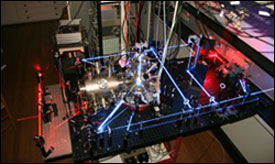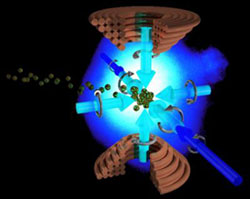
Lifetime of Excited Atoms Measured
The lifetime of an excited magnesium atom has been successfully determined to be half an hour — the longest ever measured in a laboratory. These results will impact the development of ultraprecise atomic clocks.
In the experiment, atomic physicists at the Niels Bohr Institute captured up to 108 magnesium atoms using ultraviolet laser beams and a magneto-optical trap, then cooled them to near absolute zero. The atoms were then energized with laser light that caused the electrons to jump from their ground state into a long-lasting, or metastable, excited state.

The experimental setup in the laboratory. The atoms are captured in the magneto-optical trap in a vacuum chamber in the middle of the image using ultraviolet laser light. The magnetic coils sit inside the chamber. The red laser light is used to transfer the atoms to the metastable state. (Images: Niels Bohr Institute)
“Some atoms are easy to manipulate, while others are more difficult to get to jump into an excited state, and the harder it is to get them to jump, the longer they last,” said Philip G. Westergaard, a member of the institute team that is working to develop an atomic clock based on ultracold magnesium atoms.
The metastable atoms are transferred to a magnetic trap so the researchers can exploit their quantum properties. The electrons, moving in their fixed orbits around the nucleus, are forced by ultrastable laser light to jump back and forth between these orbits; this is what constitutes the pendulum in the atomic clock.

Illustration of the magneto-optical trap. The atoms (green spheres) are captured and cooled using three pairs of opposing laser beams (blue arrows) and a magnetic field generated by coils placed above and below the atoms.
“Our results with keeping the atoms in the excited state for a very long time give us better control of the electrons jumping between orbits, and this means that the quantum uncertainty is reduced,” said Jan W. Thomsen, associate professor of ultracold atoms and quantum optics at the institute. “This can be used to develop an atomic clock that is so accurate that it only loses one second per 900 million years.”
Ultraprecise atomic clocks can be used to verify Einstein’s general theory of relativity as well as test whether constants of nature change over time, for example the fine structure constant, which describes the size of the electron energies of the atomic structure. In addition, atomic clocks can be used for navigation (GPS) and high-speed telecommunications.
For more information, visit: www.nbi.dk
Published: September 2011